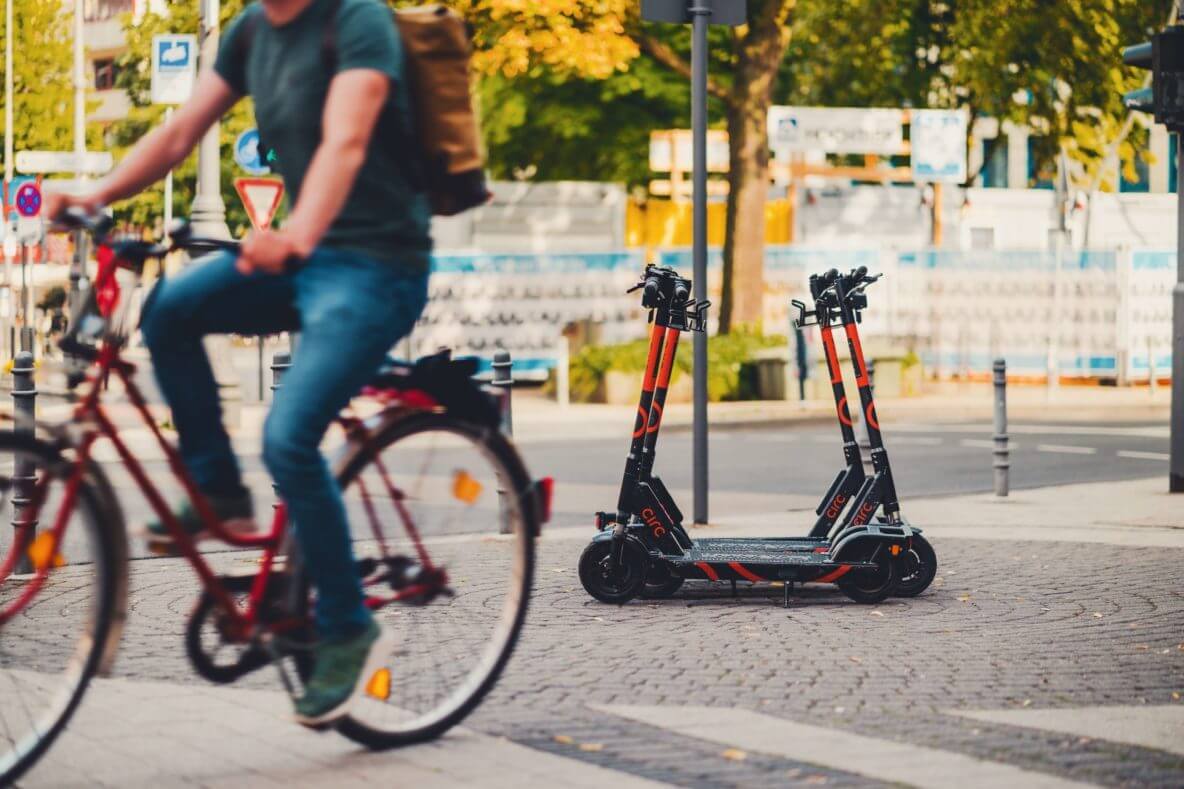
Inhaltsverzeichnis
E-Scooter: Was taugen sie wirklich?
Im Sommer 2019 sind sie in Deutschland über Nacht wie Pilze aus dem Boden geschossen: Die E-Scooter. Seitdem gibt es gespaltene Meinungen: Die einen finden, dass die E-Scooter nachhaltig sind und den Verkehr entlasten; die anderen hingegen sind genervt und sehen in den Rollern eher eine Gefahr auf den ohnehin schon ausgelasteten Fahrradwegen. Wie steht es also wirklich um die Nachhaltigkeit der E-Scooter?
Die grundlegenden Fakten
Die E-Scooter, auch E-Tretroller oder E-Stehroller genannt, sind seit dem 15. Juni auf Deutschlands Straßen zu finden. Ja, sie sind seitdem sogar kaum zu übersehen. Deutschland ist dabei aber kein Vorreiter; in vielen europäischen Metropolen gibt es die Roller nämlich schon seit Anfang 2018.
Gefahren werden dürfen die 20 km/h schnellen E-Scooter ab einem Alter von 14 Jahren, und zwar auf Radwegen. Eine Helmpflicht gibt es nicht. Die E-Scooter müssen versichert sein. Und das war’s auch schon an grundlegenden Regeln.
Die Argumente
Wenn man sich im Bekanntenkreis umhört, sind die häufigsten Argumente, die für die Benutzung von E-Scootern sprechen, folgende:
- Es macht Spaß!
- Die Dinger sind praktisch; man kommt schnell überall hin und muss nicht erst das Fahrrad aus dem Keller holen.
- Man kann von dort aus starten, wo man gerade ist.
- Die E-Scooter sind eine nachhaltigere Alternative zum Autofahren.
- Man fühlt sich frei und flexibel.
Argumente gegen die E-Scooter gibt es aber auch einige:
- Sie verschmutzen das Straßenbild. Es nervt, dass sie überall herumstehen, kaum einer stellt sie richtig ab.
- Die Dinger sind unsicher und stellen daher eine Gefahr dar.
- Auf den Fahrradwegen ist nicht genug Platz.
- Wir wissen doch noch gar nicht, ob sie wirklich eine ökologische Alternative zum Verkehrssystem darstellen…
Aber was ist denn nun an den Argumenten dran?
Flexibilität und Freiheit
An diesem Argument ist wohl kaum etwas auszusetzen. Wer schnell von A nach B kommen möchte, kann sich einen E-Scooter schnappen und ist ratzfatz am Zielort – zumindest schneller als zu Fuß. Teuer sind sind die Roller auch nicht wirklich: Wer einen solchen Roller fahren möchte, zahlt 1 Euro. Pro Minute Fahrt kommen dann, je nach Stadt, 15-30 Cent hinzu.
Stadtbild
Ich muss sagen, dass mich die E-Scooter manchmal auch nerven. Scooter, die Mitten auf dem Gehweg abgestellt oder in den nächsten Graben geschmissen wurden – Das ist ganz bestimmt nicht Sinn der Sache. Es wäre mit Sicherheit gut, wenn das E-Scooter-System noch weiter ausgebaut werden könnte; wenn es mehr feste Abstellplätze gäbe und die Straßen besser für die Fahrt mit einem solchen Roller ausgebaut bzw. optimiert wären. Vielleicht ist das Ganze für viele von uns auch nur Gewöhnungssache; manchmal tun wir uns eben schwer mit neuen Dingen und machen sie daher erst einmal schlecht.
Sicherheit
Europaweit gibt es leider schon einige Todesfälle von Menschen, die bei Unfällen mit E-Scootern ums Leben gekommen sind. Dass keine Helmpflicht besteht, macht die Sache natürlich nicht sicherer. Auch das Fahren zu zweit auf einem elektrischen Stehroller stellt eine Gefahr dar. Frankreich hat aus diesen Gründen erst kürzlich die Regeln zum Fahren mit E-Scootern verschärft. So müssen diejenigen, die ihr Handy beim Fahren benutzen oder zu zweit fahren, dort nun mit einem Bußgeld von 35 Euro rechnen. In Frankreich gilt jetzt eine Höchstgeschwindigkeit von 25 km/h; die E-Scooter dürfen aber weiterhin (wenn auch mit verschärften Regeln) auf Gehwegen gefahren werden.
In Deutschland sind diese Regeln von vornherein strenger (die Höchstgeschwindigkeit liegt bei 20 km/h; es darf nur auf Radwegen gefahren werden), aber auch hier gibt es Bußgelder: 20 Euro bei Behinderung anderer Verkehrsteilnehmer und 10 Euro Strafe bei Zu-Zweit-Fahren. Den vollständigen Bußgeldkatalog kannst du dir hier ansehen. Das Problem hierbei ist stets, dass die Verstöße überhaupt wahr- und aufgenommen werden müssen…
Momentan gibt es in Deutschland vier große Anbieter: Lime und BIRD aus den USA, voi aus Schweden, circ aus Luxemburg und TIER, ein Berliner Startup. Kommenden Frühling kann man damit rechnen, dass nochmal ein paar Anbieter hinzukommen.
Für die Sicherheit besser wäre hingegen eine Reduktion der Anzahl der Anbieter. Denn dann würde auch die Anzahl der E-Scooter selbst sinken.

Nachhaltigkeit der E-Scooter
Kommen wir nun zum wirklich spannenden Punkt: Wie steht es um die Nachhaltigkeit der E-Scooter?
Zunächst ist es so, dass die E-Tretroller elektrisch fahren und leichter und kleiner als Autos sind. Somit produzieren sie auch weniger CO2. Wie viel das letztendlich wirklich bringt, ist aber noch nicht klar. Denn dazu gibt es noch keine offiziellen Studien.
Erste Einschätzungen und Vergleiche mit E-Bikes zeigen, dass ein E-Scooter beim Laden des Akkus, um 1 km weit fahren zu können, rund 5 g CO2 produziert. Bei gleicher Strecke verbrennt ein Auto rund 120 g CO2. Die reinen Zahlen sprechen also für den E-Scooter. Aber reicht das aus, um ihn als nachhaltig zu bezeichnen?
Momentan bedeuten die Scooter erst einmal nur mehr Fahrzeuge auf den Straßen. Fragwürdig ist, ob mit den E-Tretrollern wirklich Autofahrten ersetzt werden. Es scheint, als nutzen besonders Fußgänger die Roller zum Überbrücken von längeren Strecken. Damit stellen sie keine Ergänzung des öffentlichen Nahverkehrs dar, sondern behindern diesen eher. Statt in Bus oder Bahn zu sitzen, fahren einige nun E-Scooter. Und ob das wirklich nachhaltig ist, wage ich zu bezweifeln.
Damit E-Scooter in Zukunft wirklich zu mehr Nachhaltigkeit und einer besseren Klimabilanz beitragen können, müssten sich drei Dinge ändern:
1. Das Nutzungsverhalten:
E-Scooter sollten den Autoverkehr ersetzen. Sie können beispielsweise super für die “letzte Meile” verwendet werden; also für den Weg von Zuhause zu Bus oder Bahn. Hinzu kommt, dass es die elektrischen Stehroller nur in Großstädten gibt, in denen der öffentliche Nahverkehr sowieso schon gut ausgebaut ist. Auf dem Land gibt es sie nicht, obwohl sie genau dort gute Alternativen zu Autos darstellen würden. Dass es die Scooter auf dem Land nicht gibt liegt daran, dass das Geschäft für die Anbieter erst ab ca. 100.000 Einwohnern rentabel wird.
2. Die Batterie:
Die Akkus in den Rollern sind fest verbaut. Daher müssen die E-Scooter abends von Mitarbeitern eingesammelt und aufgeladen werden. Aufgesammelt werden sie häufig von Diesel- oder Benzin-Sprintern, was der Ökobilanz nun wirklich nichts bringt. Einige Anbieter arbeiten nun an E-Scootern, die mit austauschbaren Batterien ausgestattet sein werden und so nicht mehr bewegt werden müssen. E-Cargobikes tauschen die Batterien dann direkt vor Ort aus. Das würde die Situation schon deutlich verbessern.
3. Die Langlebigkeit:
Die E-Scooter müssen für eine gute Klimabilanz länger halten. Momentan halten sie laut Hersteller circa ein Jahr. Leider gehen viele mit den E-Scootern nicht so umsichtig um wie mit einem eigenen Scooter. So landen die Roller in Marseille im Hafen, in Griechenland irgendwo in der Natur und in Paris werden falsch abgestellte E-Scooter als Sperrmüll entsorgt…
Immerhin sind die E-Scooter so gebaut, dass einzelne Teile ausgetauscht werden können, wodurch die Lebensdauer zum Teil deutlich erhöht werden kann.
Wir können also festhalten, dass die E-Scooter dem Klima momentan noch nicht wirklich etwas bringen. Sie sind an sich zwar klimafreundlicher als Autos, aber damit das auch wirklich zählt, müssen sie Autofahrten ersetzen. Es ist noch nicht klar, ob es sich um einen Hype handelt, bei dem sehr viel Elektroschrott entsteht, oder um einen wirklich rentablen Markt. Das wird sich zeigen.
Was denkst du über E-Scooter und deren Nachhaltigkeit?
Wenn du noch mehr über die Themen Nachhaltigkeit, Achtsamkeit oder gesunde Ernährung erfahren möchtest, schaue doch mal hier vorbei.




























Leave a comment
This site is protected by hCaptcha and the hCaptcha Privacy Policy and Terms of Service apply.